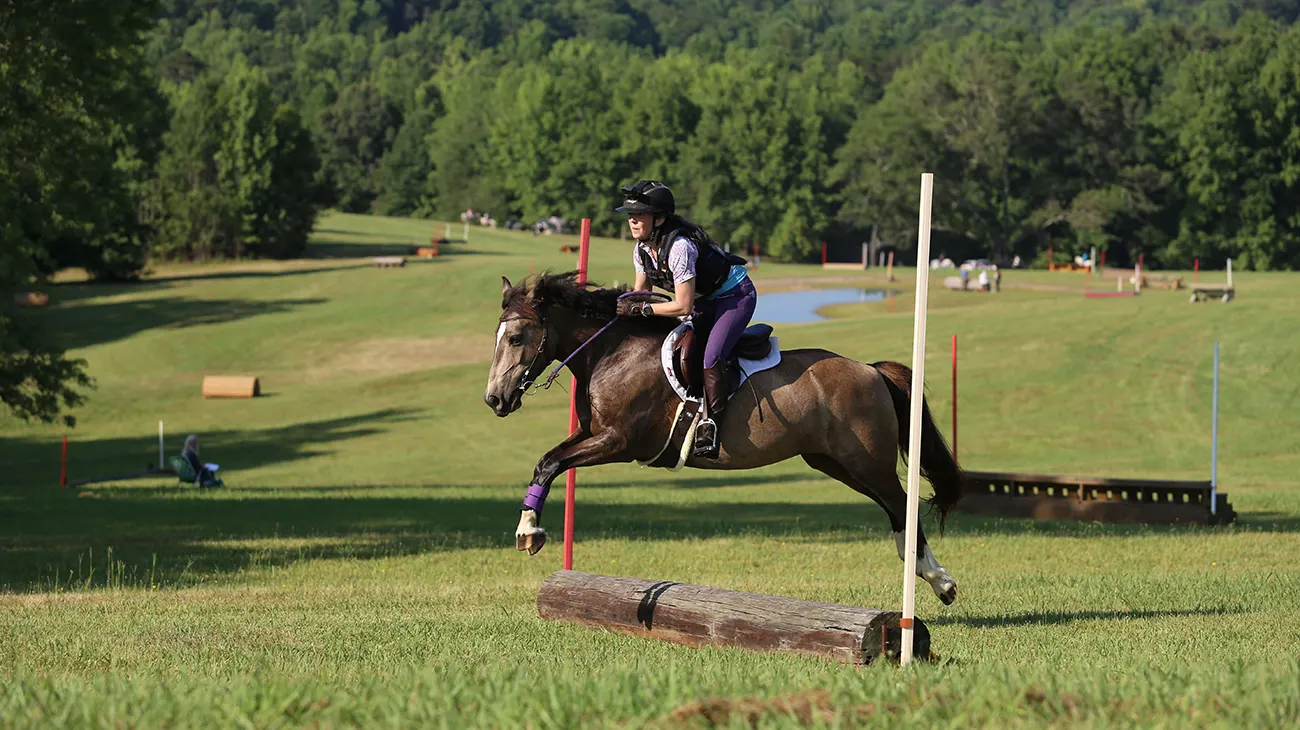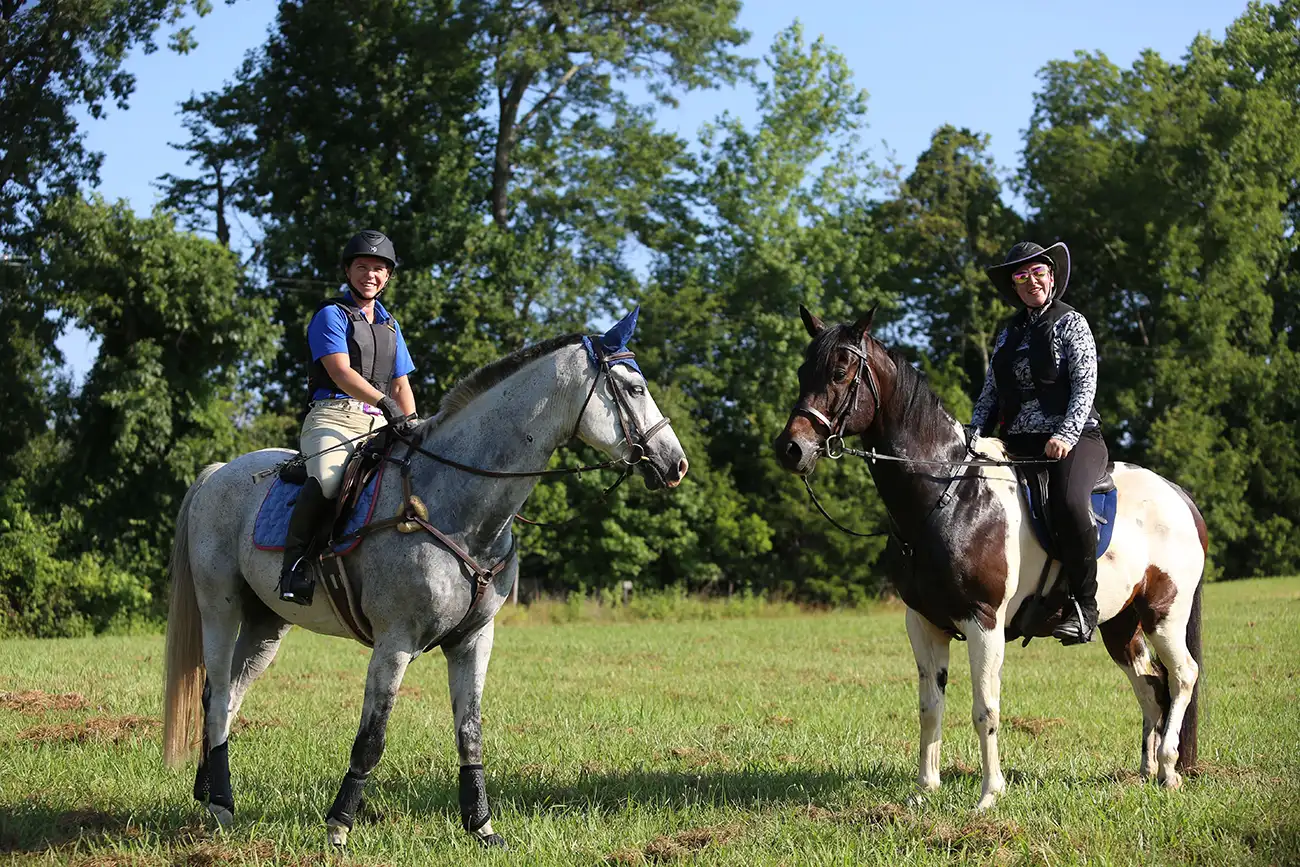On a steamy Saturday in North Carolina, a group of riders got the opportunity to try a novel competition format, cross country equestrian. The competition format, which exclusively tests cross-country jumping and allows riders to decide which fences on a course they want to jump—and which they’d rather skip—was developed by 1998 Rolex Kentucky Three-Day Event winner Nick Larkin as a fun, educational and accessible alternative to traditional horse trials.
The June 28 CCE workshop at the Foothills Equestrian Nature Center in Tryon, North Carolina, was held to educate both officials and competitors about the new format. The workshop included a Friday course walk with Larkin, where he explained the format and familiarized riders with the fences, as well as Saturday’s competition offering five levels, from introductory (Level 1) to the equivalent of training-level cross-country (Level 5). It attracted many riders who were interested in eventing or cross-country jumping but had been intimidated to try a full horse trials, as well as established eventers eager to give the new format a spin.

Larkin, who is based in Lexington, Kentucky, said the 35 horse-and-rider combinations that attended the FENCE workshop completed about 50 rounds, with one combination retiring from the course. Most, if not all, competitors were trying CCE for the first time, Larkin said, adding that he received mostly positive feedback from competitors.
In CCE, riders try to finish with the highest score, earning points for jumping obstacles and avoiding penalties for errors and time faults. The entire competition is objectively scored, so there are no opinions or biases affecting the results. Along with fences being optional, the format differs from the cross-country phase of traditional eventing in that, in a workshop competition, riders could choose to tackle the course in pairs or groups if they wanted. CCE competitors also earn bonus points for riding in a simple snaffle or not using a whip and martingale.
“Looking over the score sheets, you can tell when a rider is making smart tactical decisions and when they’re in ‘sledgehammer mode,’ ” he said. “The scores tell a clear story of how the course was being ridden.”
Putting The Horse First
Melissa Coates, from Shelby, North Carolina, attended the workshop as she prepares to make her novice eventing debut on her Irish Sport Horse Rathcoole Rock N Roll Kid. They competed in Level 4, which is similar to novice level.
“I felt like it would be a good way to get his feet wet without doing a whole horse trial,” she said. “It was really fun! It’s a great way to have a low-pressure exposure to the level and the jumps, and I really like that we have the option to jump a fence or not jump a fence and not get penalized. Every horse and rider are at a different level on a given day, and this gives you the opportunity to do what’s right for your horse on that day.”
Crossing the finish line shortly after Coates, novice-level eventer Brittney Burgett (Asheville, North Carolina) said she took advantage of the optionality of CCE to make good decisions for her horse, Heroe CDF, as the pair is coming back to competition after a break.
ADVERTISEMENT
“I actually broke my foot eight weeks ago, and this is our first competition back, so I think it felt lower pressure,” she said. “He was also tired, which he’s usually not, so I actually skipped some jumps, which was nice, because it would be a 20-point refusal on a normal course, and that would go on our [U.S. Eventing Association] record.
“It felt like the right thing to do for him, and I felt like a good horse mom, making a good choice for him,” she added, “versus this drive to be overly competitive. We skipped a couple of jumps that felt big for us, because coming up the big hill on course he felt gassed, and it just felt like the safest move.”
Competing at Level 2, Kris Astle, from South Fork, South Carolina, rode Saltwell’s Little Wild Thing, a 10-year-old Mustang mare from Wyoming she previously evented at starter level, though Saturday was the mare’s first competitive cross-country run in two years.

“I absolutely love this format because it is so approachable and so safe,” Astle said. “You don’t have to put yourself into a situation where you’re doing something that feels like too much. Even my daughter, who doesn’t event because it terrifies her, walked the course with me yesterday and was like, ‘Oh, I would do this!’ ”
Astle said she particularly appreciates CCE’s “emphasis on horse relationship.”
“If you ride in a snaffle, you get bonus points; if you ride without a martingale or a whip, you get bonus points,” she said. “It really is rewarding that relationship.
“You’re just trying to accumulate a set amount of points,” she continued. “You get a set amount of points for each jump, and there are some challenge points that give extra points, and there’s a hefty penalty for a refusal, which really rewards knowing what your horse can do.”
Astle said that she left a couple of jumps out—one that looked overly challenging, and one near the end of the course where she felt like her horse might be getting tired. As for the format, she said, “She actually is a very lovely dressage horse, but to get a horse fit to do all three phases in one day, especially in this heat, is a big ask. I really like this because it’s a good opportunity to go and do a competitive cross-country ride in a safe environment and just build that confidence in the horse and work on their fitness, so I really hope they do more.”
A Good First Impression
Beverly Padgett drove about three hours from Moore County, North Carolina, to compete at FENCE, and rode the introductory Level 1 course together with her daughter Sarah.
ADVERTISEMENT
“Since this is a workshop, we’re all learning,” Padgett said. “The points count in the overall standings, but the judges are new, the event is new, the riders are new to the sport, so we had a course walk last night and this morning, and one of the organizers came out and explained all the jumps, how they’re being scored, and how to make it obvious if you intend to skip a jump.”
Both mother and daughter were tackling a cross-country course for the first time, so it was a nice bonus that they were able to ride the course together.
“I’m an old hunter/jumper turned endurance racer, and she has aspirations for eventing, so I’m here supporting her,” Padgett said. “It’s all about the memories.”
Also competing in Level 1, Casey Delap of Greenville, South Carolina, has only had her horse, Carytol PS, a 9-year-old Oldenburg, for about a month. She hadn’t jumped in roughly 15 years until pairing up with him.

“I’d watched Karinn, my oldest, jump on him and thought it looked like a lot of fun, so here we are,” Delap said.
Both of her daughters, Karinn and Audrey, also rode later in the day. The three of them walked the course on Friday with Nick Larkin and appreciated that he explained how the jumps and course worked, and how points would be awarded and penalties applied. Delap rode with another competitor, Gwen Roberts, who was nervous because her horse tends to go too fast; since Delap’s horse is a slowpoke, they paired up for a calmer, slower round.
“He’s done cross-country once before, and I’ve had him for about two years,” Roberts said. “He was a basket case, so we’ve just been piddling around doing dressage, working equitation, some hunter paces. We do everything except jumping, because I’m too nervous. But he loves jumping, so this was perfect, because we could skip the jumps that I was afraid to do.
“We sometimes do little schooling shows, but I’m not that confident,” she added. “I love that we didn’t get disqualified for skipping jumps. I think we did three total jumps, which is more jumps that we’ve ever done. The other nice thing about this is I paid $20 to do a second course if I so choose. I don’t even like to go cross-country schooling because it gets so crowded, but here you get the field to yourself for at least a few minutes and then you can just choose what you want to do. I loved it.”
To learn more about CCE and see a calendar of future workshops and competitions, click here.














